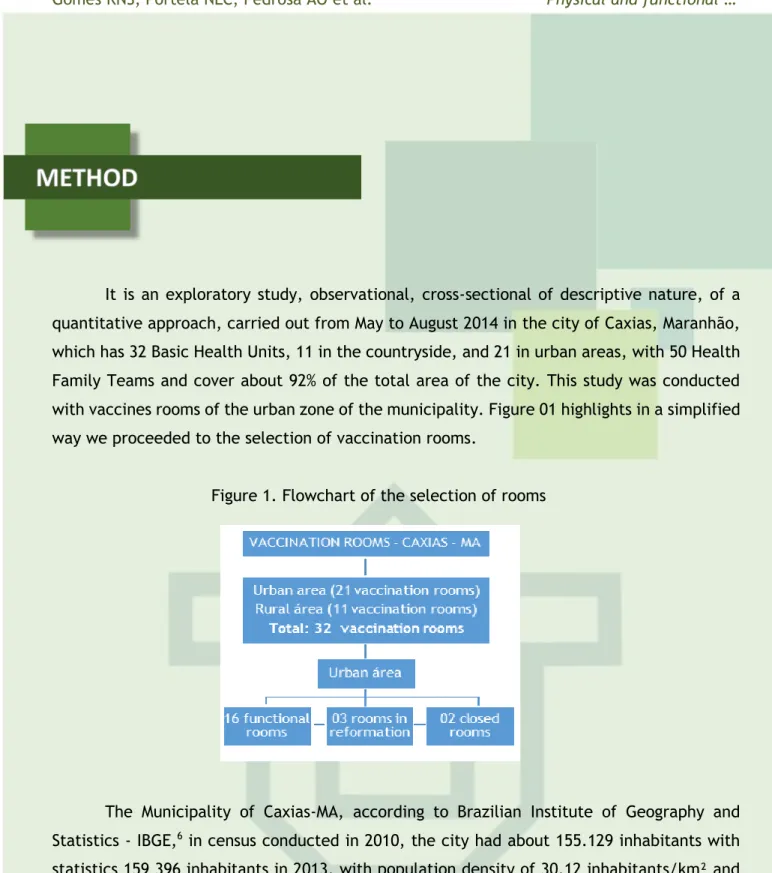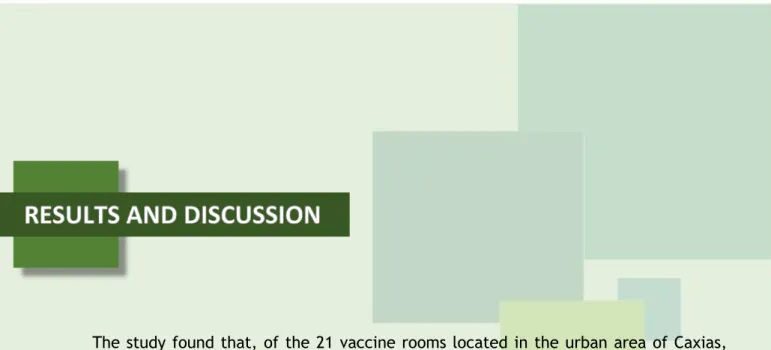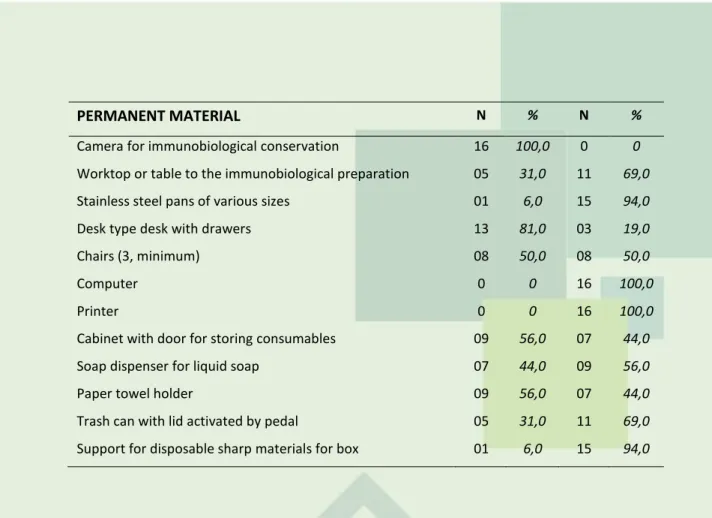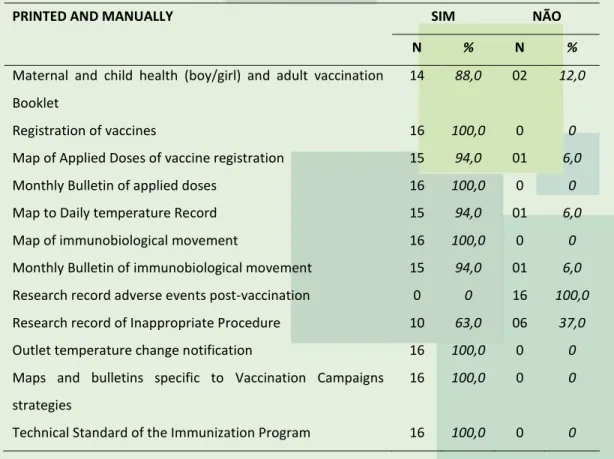J. res.: fundam. care. online 2016. jan./mar. 8(1):3793-3802
3793
Avaliação físico-funcional de salas de vacinas da rede pública municipal de Caxias-MAPhysical and functional evaluation of vaccination rooms from the public municipal network of Caxias-MA Evaluación física y funcional de las salas de vacunas de la red pública municipal de Caxias-MA Raimundo Nonato Silva Gomes ¹, Nytale Lindsay Cardoso Portela ², Aliny de Oliveira Pedrosa ³, Juliane Danielly Santos Cunha 4, Luma Ravena Soares Monte 5, Charlles Nonato da Cunha Santos 6
Objective: evaluating the standardization of vaccination rooms in Caxias, Maranhão. Method: this is an exploratory, observational, cross-sectional study of descriptive type, of a quantitative approach, conducted in the period May to August 2014 in 21 vaccination rooms of Basic Health Units in the city of Caxias, MA. The vaccination rooms were evaluated in relation to the physical space, the permanent material, the support material and consumption, the material to extramural vaccination activity and to printed and manually. Results: from the 21 vaccination rooms, 05 were not running. Therefore, we evaluated 16 vaccination rooms. Of these, 62.5% were considered good and 37,5% achieved bad index. Conclusion: in the present study, we observed failures in various vaccination rooms, making it difficult to provide a service of suitable protection, standardized by the Ministry of Health. Descriptors: Health services evaluation, Vaccines, Immunization programs.
Objetivo: avaliar a padronização das salas de vacinas da cidade de Caxias, Maranhão. Método: trata-se de um estudo exploratório, observacional, transversal de cunho descritivo, com abordagem quantitativa, realizado no período de maio a agosto de 2014 em 21 salas de vacinas das Unidades Básicas de Saúde do município do Caxias-MA. As salas de vacinas foram avaliadas em relação ao espaço físico, ao material permanente, ao material de apoio e consumo, ao material para atividade de vacinação extramuros aos impressos e manuais. Resultados: das 21 salas de vacinas, 05 não estavam em funcionamento. Portanto, foram avaliadas 16 salas de vacinas. Dessas, 62,5% foram consideradas boas e 37,5% alcançaram índice ruim. Conclusão: no presente estudo observaram-se falhas em diversas salas de vacinas, dificultando a prestação de um serviço de proteção adequado, padronizado pelo Ministério da Saúde. Descritores: Avaliação de serviços de saúde, Vacina, Programas de imunização.
Objetivo: evaluar la estandarización de las salas de vacunas de la ciudad de Caxias, Maranhão. Método: se trata de un estudio exploratorio, observacional, transversal de naturaleza descriptiva, con abordaje cuantitativo, realizado en el período de mayo hasta agosto, 2014 en 21 salas de vacunas de Unidades Básicas de Salud en la ciudad de Caxias, MA. Las salas de vacunas fueron evaluadas en relación con el espacio físico, material permanente, el material de soporte y el consumo, el material para la inmunización de los manuales de extramuros e impresos. Resultados: de las 21 salas de vacunas, 05 no estaban funcionando. Por lo tanto, se evaluaron 16 salas. De éstos, el 62,5% se consideraron buenos y 37,5% alcanzaron malos índices. Conclusión: en el presente estudio, se observó fallas en las varias salas de vacunas, por lo que es difícil proporcionar una protección adecuada de servicios, estandarizada por el Ministerio de Salud. Descriptores: Evaluación de servicios de salud, Vacunas, Programas de inmunización.
1 Nurse, Doctoral Student of Biomedical Engineering (UNIVAP), Postgraduate Student Teaching in Higher Education, Urgency, Emergency Care and Pre-hospital Attendance and Intensive Care Unit. Email: raigomezz19@gmail.com 2Nurse, Specialist in Public and Family Health and Occupational Health Nursing. Assistentialist in the Family Health Unit of Santa Maria, São João do Soter - MA. Email: nytalelindsay@hotmail.com 3Nurse, Postgraduate student in Urgency, Emergency and Pre-hospital Care. Email: alinypedrosa08@hotmail.com 4Nurse, Specialist in Family Health and Occupational Health Nursing, Postgraduate Student of Teaching in Higher Education, Governess of the Faculty of Science and Technology of Maranhão - FACEMA. Email: juliane_enfer@hotmail.com 5Nurse, Postgraduate student in Health Management Services and Auditing and Occupational Health Nursing. Email: lumaravena@hotmail.com 6 Nurse, Postgraduate Student in Urgency, Emergency and Prehospital Care. Email: charlles.enf@hotmail.com
J. res.: fundam. care. online 2016. jan./mar. 8(1):3793-3802
3794
accination is considered one of the most effective and most cost-effective in the prevention of vaccine-preventable infectious diseases. Seen it in 1973, it was set up in Brazil the National Immunization Program (NIP), in order to coordinate systematic vaccination actions at national level, contributing to the intensification of immunization activities across the country.1As a preventive resource of extreme importance to the entire population of the world, which gives beyond individual protection against grave diseases, protecting the community, reducing the presence of infectious agents, the Ministry of Health included strategies of preventive actions that encourage vaccination such as campaigns, and the active search of parents and/or guardians in family health units for routine immunization.2
In order to ensure the safe handling, storage administration of biopharmaceuticals correctly, the Program recommends activities in the vaccine area being carried out by trained nursing staff generally and preferably composed of at least two technicians and nursing assistants for each work shift, and the nurse, the professional responsible for supervising the activities of the vaccine room and the constant education of staff.3
That maintaining the integrity of Rede Frio (RF), including transport and storage of the vaccines, it is a challenge that demands the full integration between the different levels. Taking into account some problems related to the lack of professionals on temperature ranges suitable for conservation, no thermometers or daily temperature monitoring, frequent exposure detection of the products to extreme temperatures (< 0 ° C and > 10 ° C) during transport and storage, inadequate organization of refrigerators, it is required as well, commitment and responsibility of the Ministry of Health EDAs teams that make up the immunization services, with the ultimate goal of ensuring that all managed products maintain their immunogenic characteristics.4
Previous studies conducted in Brazil describe failure to adhere to recommendations for conservation, need for ongoing supervision and adequacy of human resources and equipment, that way if a focused approach for vaccines rooms is necessary, which are often neglected by researchers because there are not many records on this subject in the databases of national literature.5
Since the Ministry of Health recommends the supervision of the network of cold systematically to evaluate the conditions of physical-functional area of vaccines rooms, this research was aimed at evaluating the standardization of vaccines rooms in the city of Caxias, Maranhão.
J. res.: fundam. care. online 2016. jan./mar. 8(1):3793-3802
3795
which has 32 Basic Health Units, 11 in the countryside, and 21 in urban areas, with 50 Health Family Teams and cover about 92% of the total area of the city. This study was conducted with vaccines rooms of the urban zone of the municipality. Figure 01 highlights in a simplified way we proceeded to the selection of vaccination rooms.Figure 1. Flowchart of the selection of rooms
The Municipality of Caxias-MA, according to Brazilian Institute of Geography and Statistics - IBGE,6 in census conducted in 2010, the city had about 155.129 inhabitants with
statistics 159 396 inhabitants in 2013, with population density of 30,12 inhabitants/km² and Human Development Index (HDI) of 0,614. Caxias-MA is located in the Greater Region of Eastern Maranhão, 374 kilometers from the capital of Maranhão, São Luís and 70 kilometers from Piauí, capital city Teresina.
Informatics of the Unified Health System (DATASUS) and the General Coordination of Immunization Program (CGPNI) of the Secretariat of Health Surveillance/Ministry of Health The instrument follows an approach that highlights the following aspects: 1 - Characterization of vaccines rooms in relation to the physical space; 2 - Characterization of vaccines rooms in relation to permanent materials; 3 - Characterization of vaccines rooms in relation to collateral and consumption; 4 - Characterization of vaccines rooms in material for extramural vaccination activities; and 5 - Characterization of vaccines rooms than in print and manuals. Held the classification of physical and functional structure of the vaccine room based on an overall assessment of the criteria set out in the evaluation form, which was attributed a score to each evaluated room: 90-100 points, the room is considered optimal ; and 70 to 80 points, good; 0-60 points, bad. The overall index for each point was calculated as the average score of all rooms. We used Microsoft Excel 2013 application for systematization of data, and sewing tables.
J. res.: fundam. care. online 2016. jan./mar. 8(1):3793-3802
3796
The study found that, of the 21 vaccine rooms located in the urban area of Caxias, MA, 05 were not in operation, where 03 of them were not in operation due to the fact that they are under renovation and is working temporarily at another location. Therefore, we evaluated 16 vaccines rooms.Of the 16 rooms evaluated vaccine, 62,5%, the equivalent of 10 rooms, had score between 70-80 points, and is therefore considered to be good and 37,5% (6 rooms) reached bad index, with a score between 0-60 points.
Item Physical Space (Table 1) shows that 100,0% of vaccines rooms had easy access to the public and taken for each electrical equipment, 81,0% had adequate ventilation and lighting and 56,0% contained washable walls and floors. However, an item was inadequate: 75,0% of the rooms did not sink with tap, which prevents hand washing before and after the administration of biopharmaceuticals and can cause infections in children and adults met.
Table 1. Characterization of vaccination rooms in relation to the physical space, Caxias, Maranhão, 2014.
PHYSICAL SPACE YES NO
N % N %
Easy access to the public 16 100,0 0 0
Adequate lighting and ventilation, avoiding solar light 13 81,0 03 19,0
Washable walls and floor 09 56,0 07 44,0
Sink with tap 04 25,0 12 75,0
Outlet for each electrical equipment 16 100,0 0 0
Table 2, which deals with permanent material vaccination rooms, there is a number of inappropriate items: most rooms had no computer and printer (100,0%), stainless steel trays of various sizes (94,0%), support for sharps disposal box (94,0%), bench or table for the preparation of biopharmaceuticals (69,0%), trash can with a lid actuated by pedal (69,0%) and soap to liquid soap (56,0%).
Table 2. Characterization of vaccination rooms in permanent material, Caxias, Maranhão, 2014.
J. res.: fundam. care. online 2016. jan./mar. 8(1):3793-3802
3797
Cabinet with door for storing consumables 09 56,0 07 44,0Soap dispenser for liquid soap 07 44,0 09 56,0
Paper towel holder 09 56,0 07 44,0
Trash can with lid activated by pedal 05 31,0 11 69,0 Support for disposable sharp materials for box 01 6,0 15 94,0
With regard to the support material and consumption, it can be observed in table 3 that a very critical: the lack of all immunobiological in 88,0% of vaccines rooms, which interferes with the care for the population. In addition, they observe other inappropriate items, such as: absence stamp for vaccine registration with the National Register of Health Facilities - CNES (81,0%) of 70% alcohol (75,0%) and disposable syringes (37,0%).
Table 3. Characterization of vaccination rooms in relation to the support and consumption material, Caxias, Maranhão, 2014.
SUPPORT AND CONSUMPTION MATERIAL YES NO
N % N %
All immunobiologicals 02 12,0 14 88,0
Thermometer of maximum and minimum digital 16 100,0 0 0
Clinic digital thermometer 16 100,0 0 0
Container for cotton with cover 15 94,0 01 6,0
Alcohol up to 70% 04 25,0 12 75,0
Thermal box 15 94,0 01 6,0
Reusable ice 16 100,0 0 0
Disposable syringes (1mL, 3mL, 5mL) 10 63,0 06 37,0 Disposable needles for intradermal, subcutaneous,
intramuscular use and dilution
14 88,0 02 12,0
Liquid soap 14 88,0 02 12,0
Towel paper 14 88,0 02 12,0
Plastic garbage bag 16 100,0 0 0
Office supplies (pen, pencil, rubber, stamp pad and other) 13 81,0 03 19,0 Stamp with the health unit identification 13 81,0 03 19,0 Vaccine registration stamp with CNES 03 19,0 13 81,0
J. res.: fundam. care. online 2016. jan./mar. 8(1):3793-3802
3798
Regarding the material for extramural vaccination activity (Table 4), it was found that all vaccines rooms did not have portable alcohol gel dispenser; 25,0% had no tape and 19,0% had no thermometer cable extender and / or cooler coupled with digital thermometer. However, most rooms presented the materials needed to conduct extramural vaccination activities.Table 4. Characterization of vaccination rooms in relation to material for vaccination extramural activity, Caxias, Maranhão, 2014.
MATERIAL FOR VACCINATION EXTRAMURAL ACTIVITY YES NO
N % N %
Thermometer extender cable and/or cooler with coupled digital thermometer
13 81,0 03 19,0
Own box to dispose of sharp materials 16 100,0 0 0
Portable alcohol gel dispenser 0 0 16 100,0
Printed for vaccination strategy 16 100,0 0 0
Duct tape 12 75,0 04 25,0
Table 5, which deals with printed manuals and, it is observed that most vaccines rooms had all the forms and manuals prepared by the Ministry of Health. However, 100,0% had no Events Research Form Adverse Post-vaccination; 37,0% did not contain inadequate investigation procedure Form; 12,0% did not have Child Health Handbook (boy/girl) and Adult Immunization Handbook and; 6,0% did not have Vaccine Doses Applied Registry Map, Map Registration temperature Daily and Monthly Bulletin immunobiologicals movement.
Table 5. Characterization of vaccination rooms in relation to printed and manually, Caxias, Maranhão, 2014.
PRINTED AND MANUALLY SIM NÃO
N % N %
Maternal and child health (boy/girl) and adult vaccination Booklet
14 88,0 02 12,0
Registration of vaccines 16 100,0 0 0
Map of Applied Doses of vaccine registration 15 94,0 01 6,0
Monthly Bulletin of applied doses 16 100,0 0 0
Map to Daily temperature Record 15 94,0 01 6,0
Map of immunobiological movement 16 100,0 0 0
Monthly Bulletin of immunobiological movement 15 94,0 01 6,0 Research record adverse events post-vaccination 0 0 16 100,0 Research record of Inappropriate Procedure 10 63,0 06 37,0 Outlet temperature change notification 16 100,0 0 0 Maps and bulletins specific to Vaccination Campaigns
strategies
16 100,0 0 0
J. res.: fundam. care. online 2016. jan./mar. 8(1):3793-3802
3799
unwanted immunobiologicals temperature changes.7Ensure compliance with the rules at all stages of their use - production, distribution, technical procedures of application and orientation - is important so that the original characteristics of the vaccines remain unchanged, thus maintaining their effectiveness.8 For
this reason, the physical and functional structure of the vaccines rooms must necessarily be in accordance with the standards established by Ministerial Resolution SS-24, of March 8th,
2000, so there is a quality care.
The nurse is fundamental in the administrative and technical aspects of vaccines room, must act in vaccination, supervision and training of the nursing team, in addition to answering the technical aspects related to biopharmaceuticals, the system of record keeping, inventory control, among others. Therefore, it is necessary that the Municipal Health Department provides conditions for these professionals assume such responsibilities, under penalty of having compromised the quality of vaccination services.9 However, it is observed that, in
fact, appropriate conditions are not offered for the proper functioning of vaccines rooms. Regarding the physical space demonstrated in Table 1, all vaccines evaluated rooms have easy access to the public. This result corroborates findings in other studies and with the standards.5,7-8
However, for other items related to physical space, it was found that there was adequate ventilation and lighting, sink with faucet and walls and floors washable in all vaccines rooms, as shown in Table 1, a fact that contradicts the standards established by the Ministry of Health, which considers it essential that all health units have vaccine room with conditions to promote safety during the course of the activity, should therefore provide easy access; adequate ventilation and lighting, without; however, direct incidence of light on the immunobiological; contain steel sink, marble or granite, faucet to facilitate cleaning floors and washable walls and to facilitate disinfection.7
With regard to the table 02 (Characterization of vaccination rooms in relation to the permanent material), on average, most vaccination rooms have minimal essential materials deficits to achieve the correct immunization customer who uses the said vaccines rooms. One is example is the absence in 94% of vaccination rooms of the stainless steel tray, which is used for the rest of the materials used at the time of the procedure.
Regarding the supporting material and uptake (Table 3), there is the absence of all immunobiological in most vaccination rooms. This reality limits the nursing team practices, preventing the proper development of health care and compromising the service offered, since it generates distrust in the population.10
J. res.: fundam. care. online 2016. jan./mar. 8(1):3793-3802
3800
Also be seen in Table 3, a very positive point, the presence of maximum thermometer and digital minimal and digital clinical thermometer in all vaccines rooms, which are very important for monitoring of temperature variations and, consequently, for maintaining the initial characteristics of biopharmaceuticals. On the other hand, it can be seen in Table 5, that 6.0% of vaccines rooms do not have a map to daily temperature record, essential tool to follow up.Changing the storage temperature can compromise the immunogenic potency of the vaccine, ie the features verified and certified by the producer laboratory under certain ideal conditions for storage temperature, shelf life, moisture, light and other.7
Concerning extramural vaccination, it is emphasized that these are adopted as a result of an operational and epidemiological need, making the vaccination more accessible to the population.11 Table 4, it appears that, although most vaccines rooms had the necessary
materials to carry out the activity, some rooms lack some materials required for such activity, as the thermometer cable extender and/or cooler coupled with digital thermometer.
This undermines the realization of the activity, it is necessary for the transport and conservation of biopharmaceuticals are made under appropriate conditions (refrigerator and/or cool box, reusable ice packs and thermometer), and other criteria and requirements. In extramural work, the temperature should be checked more often to be avoided possible damage to immunobiologicals.11
With regard to printed matter and manuals (Table 5), emphasizes the importance of Adverse Events After Vaccination research form (EAPV – in Portuguese), but it was found that neither of the rooms features such printed, which is key to notification of EAPV.
The incidence of EAPV varies depending on product characteristics, the individual and the administration, and may be benign and have evolving self-limited or occur more severe forms, can lead to temporary or permanent impairment and even the death of the vaccinated individual.5 for this reason, the investigation of EAPV and the temporary postponement
indication of vaccination are essential to prevent damage to health.
Despite the importance of this form, the study shows that although 52,6% of professionals to know the side effects and know how to identify those who should be referred for medical evaluation, only 31,6% perform.8 Notification should be noted, though, the
importance of the Municipal Health Department to offer the EAPV investigation records. It is believed that due to non-existence of these records, health professionals’ vaccination rooms end up neglecting the EAPV, thus contributing to the underreporting of these events, one evident factor in the State to which that municipality belongs searched. Therefore, the instant is provided to health professionals these chips, there must be training so that they can identify, without difficulty, the EAPV and carry out the notification in a timely manner.
J. res.: fundam. care. online 2016. jan./mar. 8(1):3793-3802
3801
inadequate physical space, incomplete inputs, plus insufficient materials, making it difficult to provide adequate protection service, standardized by the Ministry of Health.Given the above, it emphasizes the importance of nurses in vaccination rooms, not just limited to supervision of the work of technicians and nursing assistants, as well as the need to structure the rooms, seeking resources and charging of managers the necessary standardization, as the deficiency in this practice could compromise the quality of biopharmaceuticals offered to the population and hence the quality of care.
1. Barbieri CLA, Dias C, Santos MAN, Veras MASM, Moraes JC, Petlik MEI. Cobertura vacinal infantil em um serviço filantrópico de atenção primária à saúde do Município de São Paulo, Estado de São Paulo, Brasil, em 2010. Epidemiol Serv Saúde. 2013; 22(1): 129-39. Disponível em: http://scielo.iec.pa.gov.br/pdf/ess/v22n1/v22n1a14.pdf.
2. OliveiraVG, Pedrosa KKA, Monteiro AI, Santos ADS. Vacinação: o fazer da enfermagem e o saber das mães e/ou cuidadores.Rev Rene. 2010; 11(Número Especial): 133-141. Disponível em: http://www.revistarene.ufc.br/edicaoespecial/a15v11esp_n4.pdf.
3. Oliveira VC, Gallardo PS, Gomes T, Passos LMR, Pinto IC.Supervisão de enfermagem em sala de vacina: a percepção do enfermeiro. Texto Contexto enferm. 2013; 22(4): 1015-21. Disponível em: http://www.scielo.br/pdf/tce/v22n4/18.pdf.
4. Aranda CMSS, Moraes JC.Rede de frio para a conservação de vacinas em unidades públicas do município de São Paulo: conhecimento e prática. Rev bras epidemiol. 2006; 9(2): 172-85. Disponível em: http://www.scielo.br/pdf/rbepid/v9n2/04.pdf.
5. Vasconcelos KCE, Rocha SA, Ayres JÁ. Avaliação normativa das salas de vacinas na rede pública de saúde do Município de Marília, Estado de São Paulo, Brasil, 2008-2009. Epidemiol Serv Saúde. 2012; 21(1): 167-76. Disponível em: http://scielo.iec.pa.gov.br/pdf/ess/v21n1/v21n1a17.pdf.
6. Instituto Brasileiro de Geografia e Estatística. Censo demográfico: resultados preliminares - Caxias/MA. 2010. Disponível em: http://cidades.ibge.gov.br/painel/painel.php?codmun=210300.
7. Ministério da Saúde (BR) Secretaria de Vigilância em Saúde. Departamento de Vigilância Epidemiológica. Manual de rede de frio. 4. ed. Brasília: Ministério da Saúde, 2013.
J. res.: fundam. care. online 2016. jan./mar. 8(1):3793-3802
3802
8. Ministério da Saúde (BR) Secretaria de Vigilância em Saúde. Departamento de Vigilância Epidemiológica. Manual de rede de frio. 4. ed. Brasília: Ministério da Saúde, 2013.
9. Queiroz SA, Moura ERF, Nogueira PSF, Oliveira NC, Pereira MMQ. Atuação da equipe de enfermagem na sala de vacinação e suas condições de funcionamento. Rev Rene. 2009; 10(4): 126-135. Disponível em: http://www.revistarene.ufc.br/vol10n4_pdf/v10n4a15.pdf.
10. Samico I, Hartz ZMA, Felisberto E, Carvalho EF. Atenção à saúde da criança: uma análise do grau de implantação e da satisfação de profissionais e usuários emdois municípios do estado de Pernambuco, Brasil. Rev Bras Saude Mater Infant [Internet] 2005; 5(2).Disponível em:
http://www.scielo.br/scielo.php?script=sci_arttext&pid=S1519-38292005000200012&lng=en&nrm=iso&tlng=pt.
11. Bahia. Secretaria da Saúde. Superintendência de Vigilância e Proteção da Saúde. Diretoria de Vigilância Epidemiológica. Coordenação do Programa Estadual de Imunizações. Manual de procedimento para vacinação. Salvador: DIVEP, 2011.
Received on: 30/09/2014 Required for review: No Approved on: 17/09/2015 Published on: 07/01/2016
Contact of the corresponding author: Raimundo Nonato Silva Gomes Rua Quininha Pires, 746 - Centro – Caxias – MA – Brasil
CEP: 65.600-000 E-mail: raigomezz19@gmail.com



